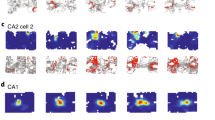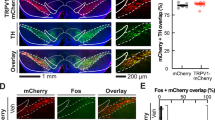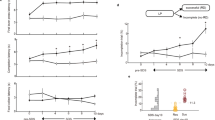Abstract
The neurobiological mechanisms underlying social learning (ie, in which an animal’s learning is influenced by another) are slowly being unraveled. Previous work with systemic treatments shows that dopamine (DA) D1-type receptors mediate social learning in the social transmission of food preferences (STFP) in mice. This study examines the involvement of one brain region underlying this effect. The ventral tegmental area has dopaminergic projections to many limbic structures, including the hippocampus—a site important for social learning in the STFP in rodents. In this study, adult male and female CD-1 mice received a dorsal hippocampal microinfusion of the D1-like receptor antagonist SCH23390 at 1, 2, 4, or 6 μg/μl 15 min before a 30 min social interaction with a same-sex conspecific, in which mice had the opportunity to learn a socially transmitted food preference. Results show that social learning was blocked in female mice microinfused with 6 μg/μl, and in males infused with 1, 4, or 6 μg/μl of SCH23390. This social learning impairment could not be explained by changes in total food intake, or olfactory discrimination. A detailed analysis of the social interactions also revealed that although SCH23390 did not affect oronasal investigation for either sex, drug treatments affected other social behaviors in a sex-specific manner; there was primarily a reduction in agonistic-related behaviors among males, and social investigatory-related behaviors among females. Thus, this study shows that dorsal hippocampal D1-type receptors mediate social learning and social behaviors in male and female mice.
Similar content being viewed by others
Log in or create a free account to read this content
Gain free access to this article, as well as selected content from this journal and more on nature.com
or
References
Amador NJ, Rotella FM, Bernal SY, Malkusz D, Cruz JA, Badalia A et al (2014). Effect of dopamine D1 and D2 receptor antagonism in the lateral hypothalamus on the expression and acquisition of fructose-conditioned flavor preference in rats. Brain Res 1542: 70–78.
Arakawa H, Kelliher KR, Zufall F, Munger SD (2013). The receptor guanylyl cyclase type D (GC-D) ligand uroguanylin promotes the acquisition of food preferences in mice. Chem Senses 38: 391–397.
Baldo BA, Sadeghian K, Basso AM, Kelley AE (2002). Effects of selective dopamine D1 or D2 receptor blockade within nucleus accumbens subregions on ingestive behavior and associated motor activity. Behav Brain Res 137: 165–177.
Bernal SY, Dostova I, Kest A, Abayev Y, Kandova E, Touzani K et al (2008). Role of dopamine D1 and D2 receptors in the nucleus accumbens shell on the acquisition and expression of fructose-conditioned flavor-flavor preferences in rats. Behav Brain Res 190: 59–66.
Box HO (1984) Primate Behavior and Social Ecology. Chapman & Hall: London.
Brann DW, Dhandapani K, Wakade C, Mahesh VB, Khan MM (2007). Neurotrophic and neuroprotective actions of estrogen: basic mechanisms and clinical implications. Steroids 72: 381–405.
Bunsey M, Eichenbaum H (1995). Selective damage to the hippocampal region blocks long-term retention of a natural and nonspatial stimulus-stimulus association. Hippocampus 5: 546–556.
Calderon DP, Kilinc M, Maritan A, Banavar JR, Pfaff D (2016). Generalized CNS arousal: an elementary force within the vertebrate nervous system. Neurosci Biobehav Rev 68: 167–176.
Cetin T, Freudenberg F, Füchtemeier M, Koch M (2004). Dopamine in the orbitofrontal cortex regulates operant responding under a progressive ratio of reinforcement in rats. Neurosci Lett 370: 114–117.
Chen YW, Morganstern I, Barson JR, Hoebel BG, Leibowitz SF (2014). Differential role of D1 and D2 receptors in the perifornical lateral hypothalamus in controlling ethanol drinking and food intake: possible interaction with local orexin neurons. Alcohol Clin Exp Res 38: 777–786.
Choleris E, Clipperton-Allen AE, Gray DG, Diaz-Gonzalez S, Welsman RG (2011). Differential effects of dopamine receptor D1-type and D2-type antagonists and phase of the estrous cycle on social learning of food preferences, feeding, and social interactions in mice. Neuropsychopharmacology 36: 1689–1702.
Choleris E, Clipperton-Allen AE, Phan A, Kavaliers M (2009). Neuroendocrinology of social information processing in rats and mice. Front Neuroendocrinol 30: 442–459.
Choleris E, Gustafsson JA, Korach KS, Muglia LJ, Pfaff DW, Ogawa S (2003). An estrogen-dependent four-gene micronet regulating social recognition: a study with oxytocin and estrogen receptor-alpha and -beta knockout mice. Proc Natl Acad Sci USA 100: 6192–6197.
Clark RE, Broadbent NJ, Zola SM, Squire LR (2002). Anterograde amnesia and temporally graded retrograde amnesia for a nonspatial memory task after lesions of hippocampus and subiculum. J Neurosci 22: 4663–4669.
Clipperton AE, Spinato JM, Chernets C, Pfaff DW, Choleris E (2008). Differential effects of estrogen receptor alpha and beta specific agonists on social learning of food preferences in female mice. Neuropsychopharmacology 33: 2362–2375.
Countryman R, Gold PE (2007). Rapid forgetting of social transmission of food preferences in aged rats: relationship to hippocampal CREB activation. Learn Mem 14: 350–358.
Ervin KSJ, Lymer JM, Matta R, Clipperton Allen AE, Kavaliers M, Choleris E (2015). Estrogen involvement in social behavior in rodents: rapid and long-term actions. Horm Behav 74: 53–76.
Floresco SB, West AR, Ash B, Moore H, Grace AA (2003). Afferent modulation of dopamine neuron firing differentially regulates tonic and phasic dopamine transmission. Nat Neurosci 6: 968–973.
Galef BG Jr (1988) Imitation in animals: history, definitions and interpretation of the data from the psychological laboratory. In: Zentall T, Galef BJ (eds). Social Learning: Psychological and Biological Perspectives. Erlbaum: Hillsdale, NJ. pp 3–28.
Galef BG Jr, Kennett DJ, Wigmore SW (1984). Transfer of information concerning distant foods in rats—a robust phenomenon. Anim Learn Behav 12: 292–296.
Galef BG Jr, Mason JR, Preti G, Bean NJ (1988). Carbon-disulfide—a semiochemical mediating socially-induced diet choice in rats. Physiol Behav 42: 119–124.
Galef BG Jr, Stein M (1985). Demonstrator influence on observer diet preference: analyses of critical social interactions and olfactory signals. Anim Learn Behav 13: 31–38.
Hansen N, Manahan-Vaughan D (2014). Dopamine D1/D5 receptors mediate informational saliency that promotes persistent hippocampal long-term plasticity. Cereb Cortex 24: 845–858.
Heyes CM (1994). Social learning in animals: categories and mechanism. Biol Rev 69: 207–231.
Heyes CM, Durlach PJ (1990). Social blockade of taste-aversion learning in Norway rats (Rattus norvegicus: is it a social phenomenon? J Comp Psychol 104: 82–87.
Hoppitt WJE, Laland KN (2013) Social Learning: An Introduction to Mechanisms, Methods, and Models. Princeton: Princeton University Press.
Hyttel J (1983). SCH 23390 - the first selective dopamine D-1 antagonist. Eur J Pharmacol 91: 153–154.
Ihalainen JA, Riekkinen P Jr, Feenstra MG (1999). Comparison of dopamine and noradrenaline release in mouse prefrontal cortex, striatum and hippocampus using microdialysis. Neurosci Lett 277: 71–74.
Lemon N, Manahan-Vaughan D (2011). Dopamine D1/D5 receptors contribute to de novo hippocampal LTD mediated by novel spatial exploration or locus coeruleus activity. Cereb Cortex 22: 2131–2138.
Lisman JE, Grace AA (2005). The hippocampal-VTA loop: controlling the entry of information into long-term memory. Neuron 46: 703–713.
Malkusz DC, Banakos T, Mohamed A, Vongwattanakit T, Malkusz G, Saeed S et al (2012). Dopamine signaling in the medial prefrontal cortex and amygdala is required for the acquisition of fructose-conditioned flavor preferences in rats. Behav Brain Res 233: 500–507.
Matta R, Ervin KSJ, Choleris E. The neurobiology of social learning. In: Olmstead MC (ed). Animal cognition: Principles, evolution, and development. NOVA Science Publishers: Hauppauge, NY, 2016, pp 171–200..
McNamara CG, Tejero-Cantero A, Trouche S, Campo-Urriza N, Dupret D (2014). Dopaminergic neurons promote hippocampal reactivation and spatial memory persistence. Nat Neurosci 17: 1658–1660.
Munger SD, Leinders-Zufall T, McDougall LM, Cockerman RE, Schmid A, Wandernoth P et al (2010). An olfactory subsystem that detects carbon disulfide and mediates food-related social learning. Curr Biol 20: 1438–1444.
Nair SG, Navarre BM, Cifani C, Pickens CL, Bossert JM, Shaham Y (2011). Role of dorsal medial prefrontal cortex dopamine D1-family receptors in relapse to high-fat food seeking induced by the anxiogenic drug yohimbine. Neuropsychopharmacology 36: 497–510.
Nakagawa S (2004). A farewell to Bonferroni: the problems of low statistical power and publication bias. Behav Ecol 15: 1044–1045.
Otmakhova NA, Lisman JE (1996). D1/D5 dopamine receptor activation increases the magnitude of early long-term potentiation at CA1 hippocampal synapses. J Neurosci 16: 7478–7486.
Phan A, Suschkov S, Molinaro L, Reynolds K, Lymer JM, Bailey CDC et al (2015). Rapid increases in immature synapses parallel estrogen-induced hippocampal learning enhancements. Proc Natl Acad Sci USA 112: 16018–16023.
Rodriguiz RM, Chu R, Caron MG, Wetsel WC (2004). Aberrant responses in social interaction of dopamine transporter knockout mice. Behav Brain Res 148: 185–198.
Rosenthal R, Rosnow RL (1991) Essentials of Behavioral Research: Methods and Data Analysis 2nd edn McGraw Hill: New York.
Rossato JI, Bevilaqua LR, Izquierdo I, Medina JH, Cammarota M (2009). Dopamine controls persistence of long-term memory storage. Science 325: 1017–1020.
Russon AE (1997) Exploiting the expertise of others. In: Whiten A, Byrne RW (eds). Machiavellian Intelligence II: Extension and Evaluations. Cambridge University Press: New York. pp 174–231.
Sanchez-Andrade G, James BM, Kendrick KM (2005). Neural encoding of olfactory recognition memory. J Reprod Dev 51: 547–558.
Sclafani A, Touzani K, Bodnar RJ (2011). Dopamine and learned food preferences. Physiol Behav 104: 64–68.
Thompson TL, Moss RL (1997). Modulation of mesolimbic dopaminergic activity over the rat estrous cycle. Neurosci Lett 229: 145–148.
Valsecchi P, Galef BG Jr (1989). Social influences on the food preferences of house mice (Mus musculus). Int J Comparat Psychol 2: 245–256.
Wise RA (2004). Rewards wanted: molecular mechanisms of motivation. Discov Med 22: 180–186.
Wise PM, Dubal DB, Rau SW, Brown CM, Suzuki S (2005). Are estrogens protective or risk factors in brain injury and neurodegeneration? Reevaluation after the Women's health initiative. Endocr Rev 26: 308–312.
Wong P, Chang CCR, Marx CE, Caron MG, Wetsel WC, Zhang X (2012). Pregnenolone rescues schizophrenia-like behavior in dopamine transporter knockout mice. PLoS ONE 7: e51455.
Acknowledgements
We thank Michelle Kivlenieks, Opoku Adjei-Afriyie, and Angela Meersseman for their help with data collection. The research described here was funded by a research grant to Elena Choleris from the Natural Sciences and Engineering Council of Canada (NSERC). We thank the Ontario Student Assistance Program for graduate scholarships to Richard Matta who was also supported by an Ontario Graduate Scholarship and Queen Elizabeth II Graduate Scholarships in Science and Technology.
Author information
Authors and Affiliations
Corresponding author
Additional information
Supplementary Information accompanies the paper on the Neuropsychopharmacology website
Supplementary information
Rights and permissions
About this article
Cite this article
Matta, R., Tiessen, A. & Choleris, E. The Role of Dorsal Hippocampal Dopamine D1-Type Receptors in Social Learning, Social Interactions, and Food Intake in Male and Female Mice. Neuropsychopharmacol 42, 2344–2353 (2017). https://doi.org/10.1038/npp.2017.43
Received:
Revised:
Accepted:
Published:
Issue date:
DOI: https://doi.org/10.1038/npp.2017.43
This article is cited by
-
Dopaminergic signaling supports auditory social learning
Scientific Reports (2021)
-
Region-dependent regulation of acute ethanol on γ oscillation in the rat hippocampal slices
Psychopharmacology (2020)
-
Glutamic acid decarboxylase 67 haplodeficiency in mice: consequences of postweaning social isolation on behavior and changes in brain neurochemical systems
Brain Structure and Function (2020)



